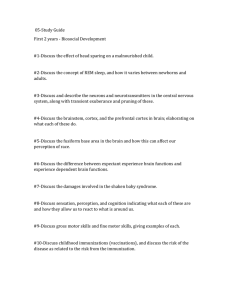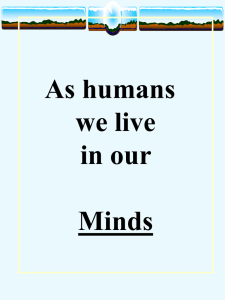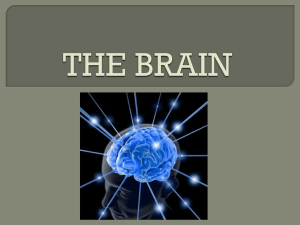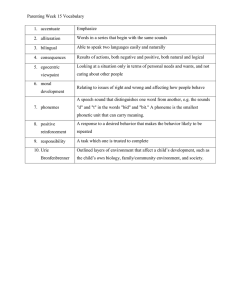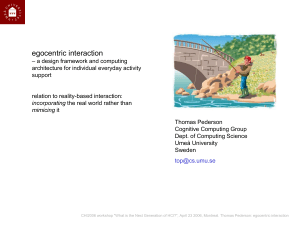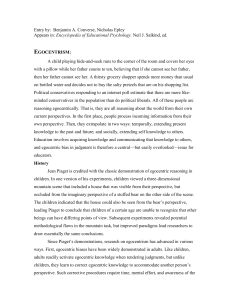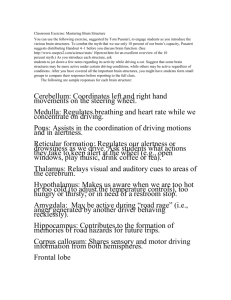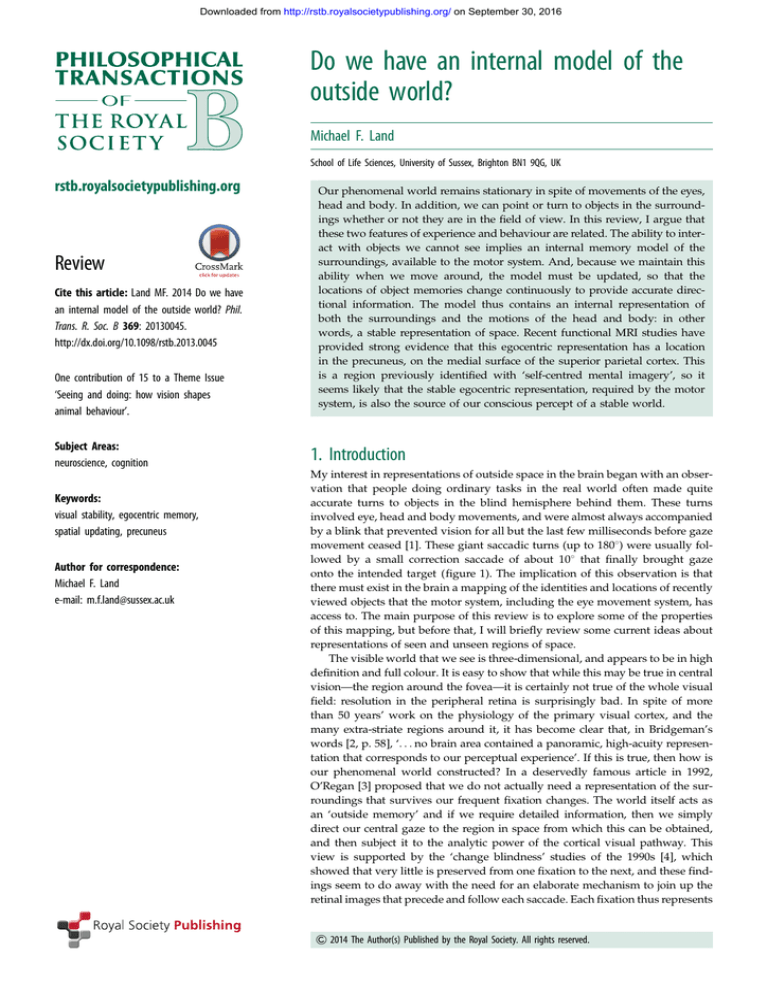
Downloaded from http://rstb.royalsocietypublishing.org/ on September 30, 2016
Do we have an internal model of the
outside world?
Michael F. Land
School of Life Sciences, University of Sussex, Brighton BN1 9QG, UK
rstb.royalsocietypublishing.org
Review
Cite this article: Land MF. 2014 Do we have
an internal model of the outside world? Phil.
Trans. R. Soc. B 369: 20130045.
http://dx.doi.org/10.1098/rstb.2013.0045
One contribution of 15 to a Theme Issue
‘Seeing and doing: how vision shapes
animal behaviour’.
Subject Areas:
neuroscience, cognition
Keywords:
visual stability, egocentric memory,
spatial updating, precuneus
Author for correspondence:
Michael F. Land
e-mail: m.f.land@sussex.ac.uk
Our phenomenal world remains stationary in spite of movements of the eyes,
head and body. In addition, we can point or turn to objects in the surroundings whether or not they are in the field of view. In this review, I argue that
these two features of experience and behaviour are related. The ability to interact with objects we cannot see implies an internal memory model of the
surroundings, available to the motor system. And, because we maintain this
ability when we move around, the model must be updated, so that the
locations of object memories change continuously to provide accurate directional information. The model thus contains an internal representation of
both the surroundings and the motions of the head and body: in other
words, a stable representation of space. Recent functional MRI studies have
provided strong evidence that this egocentric representation has a location
in the precuneus, on the medial surface of the superior parietal cortex. This
is a region previously identified with ‘self-centred mental imagery’, so it
seems likely that the stable egocentric representation, required by the motor
system, is also the source of our conscious percept of a stable world.
1. Introduction
My interest in representations of outside space in the brain began with an observation that people doing ordinary tasks in the real world often made quite
accurate turns to objects in the blind hemisphere behind them. These turns
involved eye, head and body movements, and were almost always accompanied
by a blink that prevented vision for all but the last few milliseconds before gaze
movement ceased [1]. These giant saccadic turns (up to 1808) were usually followed by a small correction saccade of about 108 that finally brought gaze
onto the intended target (figure 1). The implication of this observation is that
there must exist in the brain a mapping of the identities and locations of recently
viewed objects that the motor system, including the eye movement system, has
access to. The main purpose of this review is to explore some of the properties
of this mapping, but before that, I will briefly review some current ideas about
representations of seen and unseen regions of space.
The visible world that we see is three-dimensional, and appears to be in high
definition and full colour. It is easy to show that while this may be true in central
vision—the region around the fovea—it is certainly not true of the whole visual
field: resolution in the peripheral retina is surprisingly bad. In spite of more
than 50 years’ work on the physiology of the primary visual cortex, and the
many extra-striate regions around it, it has become clear that, in Bridgeman’s
words [2, p. 58], ‘. . . no brain area contained a panoramic, high-acuity representation that corresponds to our perceptual experience’. If this is true, then how is
our phenomenal world constructed? In a deservedly famous article in 1992,
O’Regan [3] proposed that we do not actually need a representation of the surroundings that survives our frequent fixation changes. The world itself acts as
an ‘outside memory’ and if we require detailed information, then we simply
direct our central gaze to the region in space from which this can be obtained,
and then subject it to the analytic power of the cortical visual pathway. This
view is supported by the ‘change blindness’ studies of the 1990s [4], which
showed that very little is preserved from one fixation to the next, and these findings seem to do away with the need for an elaborate mechanism to join up the
retinal images that precede and follow each saccade. Each fixation thus represents
& 2014 The Author(s) Published by the Royal Society. All rights reserved.
Downloaded from http://rstb.royalsocietypublishing.org/ on September 30, 2016
a new enquiry. This account certainly fits with the probing way
the eyes are used when we are engaged in visually demanding
tasks [5]. However, in its strong form—that there is no global
representation of the outside world at all—the outside
memory idea fails to provide a means of deciding where in
space we should look for pertinent information, nor a basis
for explaining the relationship between vision and action.
We can look round a room, then close our eyes, and point
with reasonable accuracy to the doors, windows and a few
other features. Clearly, a minimal mapping of objects and
locations is stored [6–8]. The motor system needs to have information about the location of objects relative to the head and
ultimately the trunk, and this must be accurate enough to support a range of actions. That such a working representation
does exist has been suspected for some time, and it has been
referred to as the egocentric representation [6], the spatial
image [7] and the parietal window [8]: as in an earlier account
[9], I will use the term egocentric memory here.
2. Visual stability and saccades
Another venerable problem is that the retinal image is shifted
by saccadic eye movements up to three times a second. These
not only smear the image on the retina but also displace it,
and yet we do not note these dislocations. Some argue that
this is the visual stability problem: if we can understand
how saccades are dealt with, then the problem of why the
world appears stationary will be largely solved [10].
Duhamel et al. [11] found that cells in the lateral intraparietal (LIP) area, which have a retinotopic mapping, shift the
contents of their receptive fields at the time of each saccade,
so that they anticipate the features they will encounter on the
completion of the saccade. This ‘remapping’ in area LIP, and
other cortical areas [12], is brought about in part by reafferent
signals from the superior colliculi signalling the size of the
impending saccade [13]. It is easy to see that these receptive
field shifts might make the saccadic image change a less
abrupt event, but the retinotopic image shift that results from
the saccade remains unchanged. It is thus not very clear how
this transient remapping might affect either the perception of
a scene or the relation between the line of sight and any
intended motor action on objects in the world. It seems likely
that the receptive field shifts that occur at the time of saccades,
3. The relationships of vision, egocentric memory
and motor action
The proposal here is that there exists, in the brain, a minimal
representation of the outside world that supports memory
traces of a small number of key features in the immediate
vicinity. Crucially, when someone changes position by rotating or translating, the locations of these memory traces also
change; this updating ensures that the objects they represent
maintain a constant directional relationship with the external
objects themselves.
The motor cortex appears to be organized in such a way
that the neurons responsible for movements are tuned to particular directions. Georgopoulos et al. [14] showed that single
neurons in the monkey motor cortex are tuned to hand direction, independent of the force required to achieve these
movements. The direction of the limb action appears to be a
product of the neuron population, with individual neurons
contributing to, but not uniquely specifying the direction of
the arm’s motion, and other factors such as distance of travel
may also be involved. Nevertheless, this shows that the
motor cortex, which has a fixed location in the head, contains
a representation of direction that maps onto actions. I assume
that this mapping holds not only for seen objects, which
were the subject of the Georgopoulos study, but also for the
directions of objects outside the field of view that are specified
from memory. I also assume that it holds for locomotory movements driven by the motor cortex, and for eye–head
movements mediated by the frontal eye fields. The following
example illustrates the key problem, which is to translate the
remembered location of objects into a directional command
that can be relayed to the motor system.
Consider the situation of a person in a kitchen. They decide
to get some tea bags from a cupboard 1208 to the left, which
they turn to and fixate. Having picked up the tea bags, they
then turn to another cupboard, which is 1208 left of the first cupboard, to obtain some sugar. Both cupboards will be outside the
visual field at the time of turning, although they have both been
seen before during a cursory inspection of the room. This is a
very ordinary task. In terms of the motor activity involved,
the two turns are identical, and, presumably, so too is the directional information supplied to the motor cortex. However, this
directional information is generated from the memory representations of different objects in different spatial locations. What
kind of neural organization makes this possible?
4. A rotating model: the representation of seen
and unseen objects
It will be helpful, at this stage, to contrast the ways that the
motor system deals with seen and unseen objects. For objects
Phil. Trans. R. Soc. B 369: 20130045
Figure 1. Landing points of large saccades involving eyes, head and body,
made by one subject while making a cup of tea on three occasions. All saccades were made to target objects that were initially out of sight (.908
from current gaze direction), and were accompanied by long blinks. Black
dots show landing points when gaze stopped moving, and the vestibuloocular reflex recommenced. Open circles are final landing points after a
correction saccade made under visual control. (Adapted from [1].)
2
rstb.royalsocietypublishing.org
along with saccadic suppression and change blindness itself,
are more concerned with avoiding saccadic disruption than
they are with seeing a stationary world.
This form of remapping, which takes place in a retinotopic
framework, can have little bearing on the larger question of
how different motor systems are able to access the coordinates
of objects in the surroundings, whether or not they are in the
field of view, and despite combined movements of eyes,
head and body.
Downloaded from http://rstb.royalsocietypublishing.org/ on September 30, 2016
(a)
(b)
M
M
(d)
M
M
E
V
E
V
Figure 2. Representations of a target in relation to a motor action. In (a,b),
the target is within the head-centred field of vision (V). This supplies direction information to the appropriate motor structures (M). When the head
rotates, the target direction moves across V and M. In (c,d), the target is outside the field of view and is held in egocentric memory (E). If, when the head
rotates, the memory trace does not move relative to the head (open circles)
the directional information supplied to M will be incorrect. Updating the
location of the memory trace in E (filled circles) ensures that the motor
system continues to receive correct information. (Adapted from [9].)
in the field of view, direction relative to the trunk is specified by
the approximate sum of the location of the object on the retina,
the direction of the eye axis in the head, the direction of
the head relative to the trunk and finally of the limb relative
to the trunk. Information about all four variables is readily
available from vision, proprioception or efference copy,
and the parietal cortex and pre-motor cortex contain welldocumented neural machinery for interconversion between
different representations (eye-centred, head-centred, trunkcentred etc.) [15,16]. In figure 2, I have used a head-centred
(craniotopic) representation of visual space (V); this is essentially a visual, eye-centred (retinotopic) representation with
the eye movements removed by addition of eye-in-head
position information. This has been chosen largely for convenience, but it does mean that this is a view of the world in which
objects are represented in their true positions relative to the
head, rather than in the moving retina. In such a scheme, if
the head rotates, then the image of objects in craniotopic
space moves across the visual representation (V) in the opposite
direction (figure 2a,b). This, in turn, means that the origin of the
direction information passed to the motor cortex (M) also
moves, and so the motor system is continuously provided
with new coordinates of objects in outside space on which to
base actions. I assume that the final transformation, to trunkbased coordinates, occurs in the motor cortex by addition of
proprioceptive information from the neck.
Consider now what happens to the memory trace of an
object, outside the field of view, that is being held in egocentric
5. Updating egocentric memory
In the example just given, the locations of the memory traces
of objects have to rotate within the structure that holds egocentric memory. For translational movements of the body,
they must move in one or more other dimensions. In general,
these changes that accompany body motion are referred to as
‘updating’. There have been numerous accounts (reviewed in
[6– 8]) that demonstrate that updating of egocentric memory
does indeed occur, and the requirements of an updating
system have been modelled in some detail [8].
What inputs are available to implement updating? In the
simple example of figure 2, which involves only rotation of
the head, the obvious input is from the semicircular canals of
the vestibular system, and their involvement is easy to demonstrate from the effects of prolonged rotation on the accuracy of
pointing [18]. If you rotate on an office chair for three or four
revolutions, then this will corrupt the output of the semicircular
canals and induce mild dizziness (figure 3). Take note of the
location of a landmark such as a light switch and close your
eyes, you will experience yourself rotating for a few seconds
in the direction opposite to the original rotation. When this
stops, still with the eyes closed, point to the assumed location
of the landmark and open your eyes. The direction you point
to will be wrong by an angle corresponding to the amount
you feel you have rotated when your eyes were shut. What
this demonstrates is that the incorrect vestibular signal has
resulted in incorrect updating of egocentric memory, and the
locations of memory traces of objects held in that representation
have moved accordingly, just as they would if updating were
normal and accurate. The fact that you also experience the
rotation brought about by the inaccurate vestibular signal
suggests that the updating signal not only provides information
for the motor system, but also plays a role in keeping the
phenomenal world stable during ordinary rotation.
For translational movements, the otoliths of the inertial
system can play a part, as can dead reckoning based on a subject’s own locomotory movements [7]. Visual information also
Phil. Trans. R. Soc. B 369: 20130045
(c)
3
rstb.royalsocietypublishing.org
V
V
memory (E in figure 2c). Representing memory here as a circle
is a convenient way of indicating that each memory trace has a
locus that is different from the loci of other memory traces; it
does not imply that the mapping is actually circular or even
map-like (see [17]). As with the visual representation V in
figure 2a, the structure that holds the memory (E) supplies directional information to the motor cortex M. Now, suppose that the
head rotates clockwise through 608. Unlike the situation in figure
2b, there is no visual information about the target that can change
the location of the memory trace in E. Nevertheless, if the
memory trace stayed at the same location in E, then the directional information supplied to the motor system M would be
wrong (open circles in figure 2d). To correct this, memory
traces in E must rotate by the amount the head has rotated, but
in the opposite direction (closed circles). In this way, the
directional information that E supplies to M will remain accurate.
If this formulation is correct, then it also means that there
exists in the brain a representation of external space that
rotates in such a way that the memory traces it contains
remain aligned with the corresponding objects in external
space. Apart from the advantages this has for motor control,
this could also provide the stable basis for the phenomenal
world that we see. I will return to this later.
Downloaded from http://rstb.royalsocietypublishing.org/ on September 30, 2016
(b)
fixate
landmark
(c)
close eyes
until stable
(d)
point to
landmark
provides updating information, either from simply noting the
locations of objects or from locomotion-induced flowfields.
Auditory cues and verbal instruction are also effective [19].
The egocentric memory can also be updated from long-term
allocentric memory. This other form of spatial memory is maintained in the hippocampus and other regions of the medial
temporal cortex. These representations are map-like and nondirectional, and have to be converted into an egocentric form
that is aligned with current head direction (discussed in
[6,8]). This makes possible a restructuring of egocentric
memory, so that when one moves between locations at least
some of the relevant features of the new environment are
already in place.
A scheme not very different from that outlined here
was devised by Feldman in 1985 [20], mainly to provide the
basis for a computational model of vision. As here, his scheme
contained a transient retinotopic representation, which is converted to a ‘stable-feature’ (head-based) frame by removing
eye movements. He then proposes an ‘environmental frame’
corresponding to the space around the animal, which is similar
to the allocentric memory just mentioned. Where this differs
from the present scheme is that objects outside the visual field
are held in the environmental frame, and there is no equivalent
of the active egocentric memory outlined here. Feldman also
proposes a fourth frame (a world knowledge formulary) containing information about objects and relations between them
which is conceptual rather than geometrical. Arguably, this is
the function of the ‘ventral stream’ in the formulation of
Milner & Goodale [21] although this information may be
much more generally distributed in the cortex and elsewhere.
7. Overlap with vision
Visual information is available, with varying resolution, over
most of the forward pointing hemisphere. Does this mean
that information from egocentric memory is excluded? That
this is not the case is shown by several studies which demonstrate that visual and memory information are both available
over much of the peripheral visual field. Brouwer & Knill [23]
devised a reaching task in virtual reality in which vision and
memory were pitted against each other. Two objects had to
be picked up sequentially and placed in a trash can, situated
about 308 away. In some trials, the second object was moved
a short distance while the other was being moved to the trash.
Participants did not note this, but it did affect their behaviour. When the second object was to be moved, in some
cases the arm moved in the direction of the current location
of the object, but in others it went to the object’s previous
location. Thus, the arm was sometimes guided by vision
and sometimes by memory. It turned out that the relative
weighting of vision and memory depended on the object’s
visibility, with high contrast in the scene favouring vision,
and low contrast producing more memory guidance. Thus,
the brain could choose between sources of information
depending on their reliability. In a related study by Aivar
et al. [24], the eye movements of subjects were examined
while they were engaged in a virtual task in which blocks
were picked up and moved to duplicate a pattern. Changes
were made to the layout of the blocks used to make the
copy while the subjects were looking elsewhere, but with
the blocks still visible in peripheral vision. When gaze
returned to the blocks, saccades were normally launched in
the directions of their old locations, rather than in the new,
visible locations. These two studies show that visual and
memory representations overlap in peripheral vision, and
probably throughout the visual field, and both can be used
to guide movements of either the limbs or the eyes. They
also imply that visually attended objects can be temporarily
attached to and detached from egocentric memory.
6. Properties of the egocentric memory
8. Location of the egocentric representation:
the precuneus?
Egocentric memory is not a high-fidelity representation. Pointing
experiments under conditions where the target is not visible and
the subject is not deliberately disoriented tend to come up with
Most of the regions of the parietal cortex that have been
studied electrophysiologically in connection with reaching,
grasping and saccadic fixation have spatial representations
4
Phil. Trans. R. Soc. B 369: 20130045
Figure 3. Experiment demonstrating the inaccurate updating of egocentric
memory. (a) Subject sits on a revolving chair with feet off the ground, and
is rotated through about four revolutions clockwise until mildly giddy. (b) Subject fixates a landmark and closes eyes. (c) The subject feels that he or she is
rotating anticlockwise, for 10 or more seconds. Head direction (arrow) and
target image (filled circles) have now diverged, in this case by 1358, on the
egocentric memory (represented by the grey disc). (d) When asked to point
to the landmark, the subject now points 1358 to the right of its true position.
Diagrams below show the positions of the cupula which senses rotation in one of
the horizontal semicircular canals. When forced in the ‘wrong’ direction by the
continued flow of fluid in the canal, it produces an inappropriate updating
signal. (Adapted from [18].)
accuracy estimates between 58 and 258. Similarly, large saccadic
(greater than 908) turns to objects needed in the execution of a
task, which involve rotations of eye, head and body, tend to
miss the target by about 108, and are followed by secondary saccades when vision becomes available (figure 1). The number of
object traces that can be held in egocentric memory is small,
probably in the 5–10 range. There is some decrease in pointing
accuracy with increasing object numbers (see [22]). This is
what one would expect, because egocentric memory is necessarily a form of working memory. When egocentric memories
are evoked from long-term allocentric memory, there appear to
be similar limitations on the numbers of object traces that can
be instantiated [19]. Because allocentric and egocentric memories
are interconvertible, the question of the capacity of egocentric
memory on its own is somewhat problematic.
rstb.royalsocietypublishing.org
(a)
rotate several
turns right
Downloaded from http://rstb.royalsocietypublishing.org/ on September 30, 2016
superior parietal
lobule
5
precuneus
frontal
parietal
frontal
occ.
occipital
limbic
temporal
lateral
medial
temporal
Figure 4. Outline of the left cerebral cortex showing the location of the superior parietal lobule (Brodmann area 7) and its extension, the precuneus, on the medial
face of the parietal cortex.
based on information derived from the visual field. Usually,
this representation is in an eye-centred (retinotopic) frame,
although head-centred (craniotopic) representations are also
present [15]. None of these is likely to be the site of a representation that includes the unseen half of the panorama
outside the fields of view of the eyes, nor of one whose contents move as the head and body rotate and translate in
space. It is not surprising that such a representation has not
been detected with the electrophysiological procedures used
in primate research. The subject has to be able to move, and
the ‘stimuli’ are essentially memory traces which move
around, rather than defined visual stimuli.
There is, nevertheless, evidence that there is a region of the
parietal cortex that maintains such a representation. This is
the precuneus, a continuation of the superior parietal lobule
on the medial surface of the cortex (figure 4). Based on earlier
imaging studies, Byrne et al. [8] assumed in their model that the
precuneus was the site containing the machinery of egocentric
memory, including updating during self-motion. Since then, a
number of papers have appeared reinforcing this assumption,
and I will discuss two of them.
Wolbers et al. [22] used functional MRI (fMRI) to determine
which parts of the cortex were involved in updating directional
information in a virtual environment that simulated forward
self-motion. The task consisted of identifying the locations of
one to four different peg-like targets in a textured ground
plane. These then disappeared, and for one subject group the
plane moved so as to simulate forward motion, whereas it
remained stationary for the other group. When the motion
stopped, one of the targets was shown for identification, and
the subjects had to use a joystick to point to its new (or
unchanged) location. Accuracy varied with the number of targets, indicating the involvement of spatial working memory
with its capacity limitations. Only two cortical regions
responded differently to the moving (i.e. updating) and stationary conditions. These were the precuneus and the dorsal premotor cortex. Both regions thus appeared to be involved in
the updating of spatial direction. However, when the subjects
were asked to give a verbal report of direction the pre-motor
area was no longer activated, presumably because it was no
longer involved in organizing the pointing behaviour. Thus,
the precuneus remained the only region in which working
memory was involved in directional updating.
In Wolbers et al.’s paper, the targets were all within the
frontal field of view. In a recent paper, Schindler & Bartels
[17] addressed the situation where the targets were outside
the field of view. They used a combination of fMRI and virtual reality to investigate responses to imagined locations in
eight directions in surrounding space. They found that directions were discriminated in two distinct parietal regions: in
the intraparietal sulcus (IPS) in the superior parietal cortex,
and the temporo-parietal junction region (TPJ) in the inferior
parietal cortex. In both regions, there was no overall increase
in the fMRI signal, but particular directions were discriminated in distributed patterns of active voxels. In contrast to
parts of the parietal cortex coding visual space, there was
no indication of a ‘map’ of egocentric space.
In the IPS region, discrimination of unseen directions was
strongest in regions IPS 1, 2 and 3 in what is considered to be
the ‘reach’ area. The egocentric region of IPS 1 and 2 extends
over into the precuneus on the medial wall of the parietal lobe.
Schindler and Bartels comment ‘The present evidence suggests
that the clusters in IPS 1/2 and precuneus hold the egocentric
(most likely body-centred) spatial representation, whose impairment leads to optic ataxia’ [17, p. 179]. This area does not have a
visual representation, but is bordered by regions IPS 0 and IPS 4
that do. Schindler and Bartels suggest that ‘Their distributed
overlay with visual maps may facilitate flexible remapping
between body-centred and visual coordinate systems depending
on gaze position’ [17, p. 179]. This is consistent with the overlap
between vision and memory discussed in §7. The representation
of egocentric space in the inferior parietal region TPJ is probably
not associated with action, but it is the region which, when
damaged, is typically associated with spatial neglect, a disorder
that results in objects in contralateral space being ignored.
This could result from faulty interconversion between allo- and
egocentric representations.
These two papers strongly implicate the precuneus and
superior parts of the intraparietal sulcus as regions that are
(i) involved in spatial updating of direction; (ii) concerned
with regions of space both within and outside the field of
view; (iii) addressable by imagining particular spatial locations.
This is important because to point to something behind you
requires first that you imagine where it is, i.e. direct attention
to a locus that will provide the appropriate direction vector;
and (iv) not map-like, in contrast to other vision-based parietal
regions. This is significant because a representation in which the
memory traces move as the body moves cannot have a fixed
layout in the brain. Schindler and Bartels conclude ‘. . .
egocentric space was represented in a distributed neural
Phil. Trans. R. Soc. B 369: 20130045
occ. occipital
par. parietal
rstb.royalsocietypublishing.org
par.
Downloaded from http://rstb.royalsocietypublishing.org/ on September 30, 2016
In their review of the functional anatomy of the precuneus,
Cavanna & Trimble [25] list a wide variety of functions
suggested by scanning and lesion studies. These include
visuospatial imagery, episodic memory retrieval, first-person
perspective taking and experience of agency. They conclude
that ‘activation patterns appear to converge with anatomical
and connectivity data in providing preliminary evidence for
a functional subdivision within the precuneus into an anterior
region, involved in self-centred mental imagery strategies, and
a posterior region, subserving successful episodic memory
retrieval’ [25, p. 564]. An egocentric representation of one’s
References
1.
2.
3.
4.
5.
6.
7.
8.
Tatler BW, Land MF. 2011 Vision and the
representation of the surroundings in spatial
memory. Phil. Trans. R. Soc. B 366, 596–610.
(doi:10.1098/rstb.2010.0188)
Bridgeman B. 2011 Visual stability. In The Oxford
handbook of eye movements (eds SP Liversedge,
ID Gilchrist, S Everling), pp. 511–521. Oxford, UK:
Oxford University Press.
O’Regan JK. 1992 Solving the real mysteries of
visual perception. Can. J. Psychol. 46, 461–488.
(doi:10.1037/h0084327)
Simmons DJ, Rensink RA. 1995 Change blindness:
past present and future. Trends Cogn. Sci. 9, 16– 20.
(doi:10.1016/j.tics.2004.11.006)
Land MF, Tatler BW. 2009 Looking and acting.
Oxford, UK: Oxford University Press.
Burgess N. 2006 Spatial memory: how
egocentric and allocentric combine. Trends
Cogn. Sci. 10, 551–557. (doi:10.1016/j.tics.
2006.10.005)
Loomis JM, Philbeck JW. 2008 Measuring spatial
perception with spatial updating and action. In
Embodiment, ego-space and action (eds RL Klatzky,
B Mac Whinney, M Behrman), pp. 1 –43. New York,
NY: Taylor & Francis.
Byrne P, Becker S, Burgess N. 2007 Remembering
the past and imagining the future: a neural
model of spatial memory and imagery. Psychol.
Rev. 114, 340–375. (doi:10.1037/0033-295X.
114.2.340)
9.
10.
11.
12.
13.
14.
15.
16.
17.
Land MF. 2012 The operation of the visual system in
relation to action. Curr. Biol. 22, R811– R817.
(doi:10.1016/j.cub.2012.06.049)
Klier EM, Angelaki DE. 2008 Spatial updating and the
maintenance of spatial constancy. Neuroscience 156,
801–818. (doi:10.1016/j.neuroscience.2008.07.079)
Duhamel J-R, Colby CL, Goldberg ME. 1992 The
updating of the representation of visual space in
parietal cortex by intended eye movements. Science
255, 90 –92. (doi:10.1126/science.1553535)
Hall NJ, Colby CL. 2011 Remapping for visual
stability. Phil. Trans. R. Soc. B 366, 528 –539.
(doi:10.1098/rstb.2010.0248)
Wurtz RH, Joiner WM, Berman RA. 2011 Neuronal
mechanisms for visual stability: progress and
problems. Phil. Trans. R. Soc. B 366, 492 –503.
(doi:10.1098/rstb.2010.0186)
Georgopoulos AP, Ashe J, Smyrnis N, Taira M. 1992
The motor cortex and the coding of force. Science 256,
1692–1695. (doi:10.1126/science.256.5064.1692)
Colby CL, Golberg ME. 1999 Space and attention in
parietal cortex. Annu. Rev. Neurosci. 22, 319–349.
(doi:10.1146/annurev.neuro.22.1.319)
Pertzov Y, Avidan G, Zohary E. 2011 Multiple
reference frames for saccadic planning in the
human parietal cortex. J. Neurosci. 31, 1059–1068.
(doi:10.1523/jneurosci.3721-10.2011)
Schindler A, Bartels A. 2013 Parietal cortex codes for
egocentric space beyond the field of view. Curr. Biol.
23, 177– 182. (doi:10.1016/j.cub.2012.11.060)
18. Land MF. 2010 Fairground rides and spatial
updating. Perception 39, 1675– 1677. (doi:10.
1068/p6839)
19. Loomis JM, Klatzky RL, Giudice NA. 2013
Representing 3D space in working memory: spatial
images from vision, hearing, touch and language.
In Multisensory imagery (eds S Lacey, R Lawson),
pp. 131–155. New York, NY: Springer.
20. Feldman JA. 1985 Four frames suffice:
a provisional model of vision and space. Brain
Behav. Sci. 8, 265–289. (doi:10.1017/S0140525X
00020707)
21. Milner AD, Goodale MA. 1995 The visual brain in
action. Oxford, UK: Oxford University Press.
22. Wolbers T, Hegarty M, Büchel C, Loomis J. 2008
Spatial updating: how the brain keeps track of
changing object locations during observer motion.
Nat. Neurosci. 11, 1223– 1230. (doi:10.1038/
nn.2189)
23. Brouwer A, Knill D. 2007 The role of memory
in visually guided reaching. J. Vis. 7, 1–12.
(doi:10.1167/7.5.6)
24. Aivar MP, Hayhoe MM, Chizk CL, Mruzek REB.
2005 Spatial memory and saccadic targeting
in a natural task. J. Vis. 5, 177–193. (doi:10.
1167/5.3.3)
25. Cavanna AE, Trimble MR. 2006 The precuneus:
a review of its functional anatomy and behavioural
correlates. Brain 129, 564 –583. (doi:10.1093/
brain/awl004)
6
Phil. Trans. R. Soc. B 369: 20130045
9. Egocentric memory and the stability of the
visual world
direction in relation to the surroundings would certainly fit a
description of a ‘self-centred mental imagery strategy’.
If it is the case, as advocated here, that the motor system
requires a representation of space that maintains a consistent
relationship with objects in the outside world as the body
moves within it, then this could also serve as a model of a
stable outside world of which we can be conscious. As we
have seen, this is not a high-definition representation, but it
does not have to be. All that is required is that it provides a
stable framework to which detailed information, provided by
the visual pathways through the occipital and temporal lobes,
can be temporarily attached. It is perhaps worth making a distinction between the contents of egocentric memory and the
framework itself. Space appears as continuum, independent
of the objects that from time to time populate it. It is the continuum rather than the particular contents that appears to
remain still when, for example, we look around a room. On
this view, our consciously perceived phenomenal world is a
hybrid: the machinery of the precuneus provides a temporarily
stable and sparsely populated world model, which we can use
as an index for finding the sources information we need for
action, before examining them in the way that O’Regan [3]
suggested. This certainly fits with what we feel is going on:
that we look around a stable world, parts of which move seamlessly in and out of vision, and that we retain usable information
about the identity and direction of some of the objects behind
us, as well as in front.
rstb.royalsocietypublishing.org
code. . . Our findings indicate a fundamentally distinct coding
scheme compared to that of visual space’ [17, p. 181].
The idea of a representation that rotates within a fixed
structure may seem at first outlandish, but there is a precedent for it in the study by Duhamel et al. [11] in LIP.
There, the contents of the fields of ganglion cells change
location in anticipation of a saccade, based on non-visual
information. It seems that something very similar must be
happening here, although in a different context and a different region of the parietal lobe.

